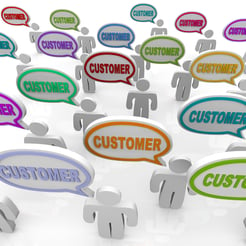Welcome to the second part of a four-part series on pricing data products. In the first installment of this series, we explored the two key methods for pricing any product: cost-based pricing and value-based pricing. For data products, value-based pricing represents the most logical approach as the marginal cost of reproducing data approaches zero quite rapidly. In this posting, we will provide a framework to thoroughly understand customers and what value a data product is actually delivering to them.
As always, subscribe to our blog to stay informed and read on for more detail on knowing your customers after the break.
Known use cases

Data Vendors on the DataStreamX marketplace should try to understand their customers as best as possible. A good first step to this understanding is to assess the various use cases for the data product. Vendors should consider many possible ways their data products could deliver value to a user. It would be remiss to price data without knowing market uses for data. Organizations use data in a variety of ways, including, but not limited to:
- Enhancing existing products
- Creating new products
- Improving customer experience
- Lowering costs
- Mitigating risk
- Improving supply chain efficiency
- Pricing more effectively
Each use case will have a different impact on an organization. Each organization will have a different opinion on the value they receive for it, and thus a different interest in buying the data product at a given price.
Vendors that can clearly define their target customer and use cases will be more capable at pricing their data products. If not, they risk overpricing for their intended targets without much supporting evidence.
Willingness to pay
A Vendor’s ultimate objective on DataStreamX should be to maximize total revenue—by converting the maximum number of customers at the highest possible price point. A data product’s ideal price would capture the customers’ maximum willingness to pay, without deterring too many prospective buyers. The challenge is that all customers are different, each with a unique willingness to pay.
Vendors can reasonably estimate customers’ maximum price they are willing to pay by examining who the target customers are and what behaviors define them. Most likely, commercial data products on DataStreamX will be most attractive to enterprise customers, also known as “B2B” customers.
For the sake of our pricing discussion, B2B organizations are made up of two relevant groups of people: users and decision makers. Users generate demand—they want the data product. Sometimes a user can make a purchase decision individually—a great situation when upper management approval is unnecessary, thus the sales cycle is short. Sometimes a user must obtain approval from decision makers—situations where the sales cycle is longer.
As stated above, a Vendor’s primary objective should be to maximize revenue. The secondary objective should be to encourage customers to make a purchase decision as quickly as possible. Once a user has realized the need for a data product, the Vendor can accelerate the purchase decision with price. We will discuss two alternatives for ‘fast-tracking’ the purchase decision for B2B customers:
- Setting price just below the threshold where users must obtain purchase approval
Each organization will have different thresholds. These can range anywhere from $1,000 to $5,000 to $15,000. With a good understanding of the target customers, Vendors should have a good understanding of their users’ threshold, before their purchases escalate to decision maker approval. - Set the price at a point where decision makers would find it hard to object
Decision makers will choose whether or not to buy a data product. They will have a hunch on what an acceptable price is—they will look at how comparable products are priced in the open market. These are called a “reference prices.”
Likewise, any data sets that are priced higher than these “premium” data products would require a significant value add above and beyond what customers currently receive from the currently available, comparable data products. We generally recommend prices do not exceed such higher end reference prices.
Decision makers will also consider “make vs. buy” scenarios. “Make vs. buy” entail decision makers comparing the price of a Vendor’s data product against the costs of building or assembling the data themselves. If the total “make” cost exceeds “buy” price of the Vendor’s product, then the decision maker would find it easier to justify purchasing the data product.
After considering currently available reference prices, data Vendors should have a better understanding of the price the market is willing to accept for a given data product. With this understanding, it is now possible to adjust pricing according to the value represented by a new data product. In our next installment of this pricing data series, we will dive deeper into the levers that drive value.
You can also skip ahead and download our complete pricing guide below. As always, we encourage anyone interested in joining the data economy to register with DataStreamX and browse our marketplace. Check us out at www.datastreamx.com today!


